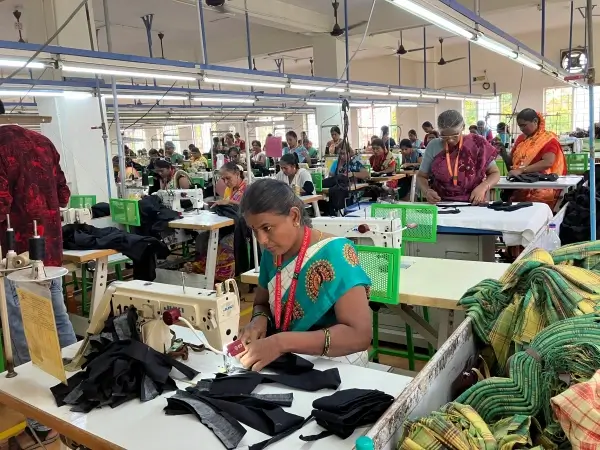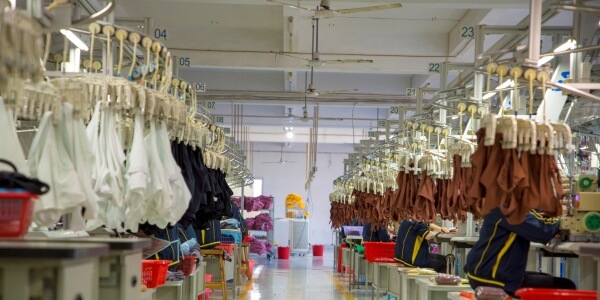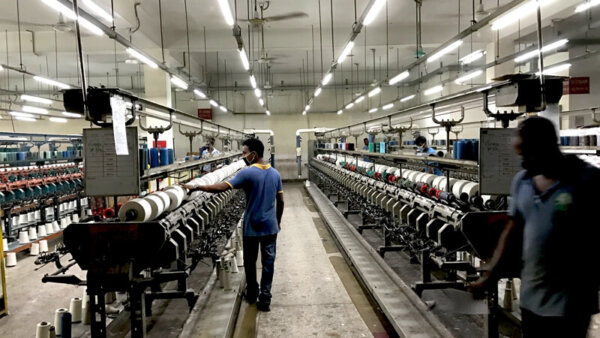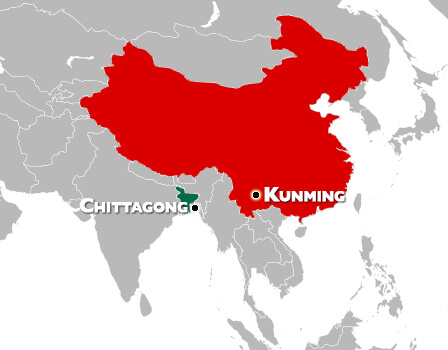Why Should Underwear Manufacturers Have Production Capabilities in Both China and Southeast Asia?
In today's volatile global trade environment, underwear manufacturers face unprecedented challenges. Rising tariffs, geopolitical tensions, and supply chain disruptions threaten business stability and profitability for companies relying on single-country production.
The optimal strategy for underwear manufacturers is maintaining dual production capabilities in both China and Southeast Asia. This approach leverages China's complete supply chain and development expertise while capitalizing on Southeast Asia's tariff advantages and lower labor costs, creating resilience against trade uncertainties and maximizing competitive advantages.

As the founder of HAVING, a leading lingerie manufacturer based in Gurao Town, Shantou City, I've witnessed firsthand how the changing trade landscape has reshaped our industry. The US-China trade tensions have forced many manufacturers to reconsider their production strategies. Let me share why we've adopted a dual-production approach and how it's benefiting our business and customers.
Why Is China Still Essential for Underwear Manufacturing Despite Rising Tariffs?
The uncertainty of US-China trade relations has created significant challenges for underwear manufacturers. Increased tariffs have raised costs, squeezed margins, and disrupted established business models that relied exclusively on Chinese production.
China remains essential for underwear manufacturing because of its unparalleled complete industrial chain, advanced technology, skilled workforce, and superior product development capabilities. These advantages enable faster time-to-market, higher quality standards, and more innovative designs that cannot be easily replicated elsewhere.

At HAVING, our Shantou facility represents the culmination of decades of expertise in lingerie manufacturing. The industrial cluster in Gurao Town provides us with immediate access to everything we need - from specialized fabrics and trims to skilled pattern makers and sample technicians. This complete ecosystem allows us to develop new products with remarkable speed and precision.
When we receive a design concept from a European or American client, we can transform it into a physical sample within days, not weeks. This rapid development cycle is possible because all necessary components and expertise are within reach. Our technicians have spent years perfecting techniques for creating comfortable, aesthetically pleasing underwear that follows our "body-before-fabric" philosophy.
The specialized knowledge required for producing high-quality bonded products is particularly concentrated in China. The bonding technology, which eliminates traditional seams for a smoother silhouette, requires specialized equipment and technical expertise that has been refined in our Shantou facilities over many years. This technology is crucial for creating modern, comfortable shapewear and seamless bras that meet the demanding standards of our international clients.
Furthermore, China's manufacturing infrastructure supports efficient large-scale production with consistent quality control. Our factory in Shantou can produce thousands of pieces daily while maintaining strict quality standards across our extensive product lines, including bras, panties, shapewear, and swimwear. You can learn more about our quality control processes on our quality control page.
How Does Southeast Asia Complement China in the Underwear Manufacturing Equation?
The rising production costs and tariff uncertainties in China have created significant financial pressure on underwear manufacturers. Without alternatives, many businesses face shrinking margins and potential loss of market share to competitors with more diversified production capabilities.
Southeast Asian countries like Bangladesh offer crucial tariff advantages and lower labor costs that complement China's manufacturing strengths. By establishing production facilities in these regions, manufacturers can mitigate tariff impacts, reduce overall production costs, and maintain competitive pricing while still leveraging China's development capabilities.

At HAVING, we've established strategic partnerships in Bangladesh that operate under the Cut-Make-Trim (CMT) model. These facilities have achieved 100% progress in the Ready-made garment Sustainability Council (RSC) standards and hold important certifications including BSCI and WRAP, ensuring ethical manufacturing practices that our European and American clients demand.
Our Bangladesh operations initially focused on cotton-based products, including sewn and seamless underwear and bras. However, we're now leveraging our extensive experience with bonded products from China to expand these capabilities in Bangladesh. This represents a significant competitive advantage, as bonded production capacity outside of China is extremely limited throughout Southeast Asia.
The tariff benefits cannot be overstated. For example, exports from Bangladesh to the EU benefit from the Everything But Arms (EBA) initiative, which allows duty-free access. Similarly, exports to the US often qualify for preferential treatment under various trade agreements. These tariff advantages can result in savings of 10-20% compared to Chinese exports, which directly impacts the final retail price and competitiveness of our products.
Labor costs in Bangladesh are approximately one-third of those in China's coastal manufacturing regions, creating significant cost advantages for labor-intensive processes. By strategically allocating production between our Chinese and Bangladeshi facilities, we can optimize our cost structure while maintaining quality standards.
What Makes the Dual-Production Strategy Superior to Single-Country Manufacturing?
Relying solely on either Chinese or Southeast Asian production creates vulnerability to trade policy shifts, currency fluctuations, and regional disruptions. This single-source dependency can lead to business continuity risks and missed opportunities in an increasingly unpredictable global market.
A dual-production strategy creates resilience through geographic diversification, allowing manufacturers to quickly shift production volumes between locations in response to tariff changes, supply chain disruptions, or currency fluctuations. This flexibility ensures business continuity, optimizes costs, and provides customers with both innovation and competitive pricing.

At HAVING, we've developed a sophisticated approach to our dual-production strategy that maximizes the strengths of each location. Our product development and sample-making primarily occur in our Shantou facility, where we can leverage China's superior technical expertise and complete supply chain. Once designs are finalized and approved, we can strategically allocate production between China and Bangladesh based on several factors:
| Decision Factor | China Production | Bangladesh Production |
|---|---|---|
| Technical Complexity | High-tech bonded products, complex constructions | Standard sewn products, basic constructions |
| Order Volume | Small to medium runs, quick replenishments | Large volume orders with longer lead times |
| Destination Market | Markets with lower tariffs on Chinese goods | EU, US, and markets with preferential agreements |
| Time Sensitivity | Urgent orders requiring faster turnaround | Seasonal planning with longer lead times |
This strategic allocation allows us to offer our customers the best of both worlds: the innovation and quality associated with Chinese manufacturing combined with the cost advantages of Southeast Asian production. For instance, we might develop a new bonded bra style in our Shantou facility, produce the initial run in China to ensure all technical aspects are perfected, and then transfer production to Bangladesh for larger volume orders once the style is established.
Our dual-production approach also provides crucial business continuity benefits. During the COVID-19 pandemic, when regional lockdowns disrupted manufacturing in various locations, we were able to shift production between facilities to minimize delays. Similarly, when trade tensions have resulted in tariff increases, we've adjusted our production allocation to mitigate the impact on our customers.
We're also planning to establish our own factory in Bangladesh, which will further enhance our control over quality and efficiency while maintaining the tariff advantages. This expansion will focus particularly on bringing our bonded product expertise to Southeast Asia, creating a unique competitive advantage as this capability is currently scarce in the region. Learn more about our manufacturing capabilities on our website.
How Can Underwear Brands Benefit from Manufacturers with Dual-Production Capabilities?
Underwear brands face intense market pressure to maintain competitive pricing while delivering innovation and quality. Single-source manufacturing often forces compromises between cost, quality, and flexibility that ultimately weaken market position.
Brands partnering with dual-production manufacturers gain significant advantages: tariff optimization for better pricing, risk mitigation through geographic diversification, and access to both China's innovation capabilities and Southeast Asia's cost benefits. This comprehensive approach enables brands to remain competitive across multiple market segments.

At HAVING, we've seen firsthand how our dual-production capabilities have benefited our brand partners. One European lingerie brand we work with was struggling with pricing pressure in their mid-market segment due to tariffs on Chinese goods. By strategically shifting production of their core styles to our Bangladesh operation, we helped them reduce landed costs by approximately 15%, allowing them to maintain their retail price points without sacrificing margins.
Meanwhile, they continue to leverage our Chinese facility's expertise for their premium lines and new product development, where technical innovation and quality are paramount. This balanced approach has allowed them to compete effectively across different market segments.
Our American clients particularly benefit from our ability to navigate the complex and changing tariff landscape. When new tariff announcements create uncertainty, we can quickly provide alternative production scenarios with detailed cost implications, allowing brands to make informed decisions about their sourcing strategy.
The risk mitigation aspect cannot be overstated. Brands that rely on us appreciate having production continuity options when regional issues arise. During recent supply chain disruptions, our clients maintained product availability while competitors faced stockouts and delays.
For emerging brands, our dual-production model offers another significant advantage: scalability. They can start with smaller, more manageable production runs in China during their product development and market testing phases. Once they're ready to scale, we can transition production to Bangladesh for more favorable cost structures on larger volumes.
Our commitment to bringing bonded product capabilities to Southeast Asia is particularly exciting for our brand partners. This technology, which creates smoother silhouettes and enhanced comfort in intimate apparel, has traditionally been available primarily from Chinese manufacturers. By establishing this capability in Bangladesh, we're offering brands the rare opportunity to combine this premium construction technique with Southeast Asian cost advantages.
Conclusion
In today's uncertain trade environment, underwear manufacturers must embrace a dual-production strategy spanning China and Southeast Asia to remain competitive. This approach combines China's innovation with Southeast Asia's cost advantages, creating resilience against trade disruptions.
Frequently Asked Questions (FAQ)
What are the main advantages of manufacturing underwear in China?
China offers a complete industrial chain for underwear manufacturing, with advanced technology, skilled workers, and superior product development capabilities. This ecosystem enables faster time-to-market, higher quality standards, and more innovative designs, particularly for technically complex products like bonded underwear and bras.
Why are Southeast Asian countries becoming important for underwear production?
Southeast Asian countries like Bangladesh provide significant tariff advantages when exporting to markets like the EU and US. They also offer lower labor costs (approximately one-third of China's coastal regions), making them ideal for large-volume production of established styles where labor is a significant cost component.
What is bonded technology in underwear manufacturing?
Bonded technology uses heat and adhesives to join fabrics without traditional stitching, creating seamless edges and smooth silhouettes in underwear and intimate apparel. This technique is particularly important for modern shapewear and seamless bras that provide comfort without visible seam lines under clothing.
How does the CMT (Cut-Make-Trim) model work in underwear manufacturing?
In the CMT model, the manufacturer handles only the cutting, sewing, and finishing of garments, while the client typically provides or specifies the fabrics and designs. This approach allows brands to maintain control over materials while leveraging the manufacturing expertise and labor cost advantages of facilities in countries like Bangladesh.
What certifications should brands look for when selecting underwear manufacturing partners?
Important certifications include WRAP (Worldwide Responsible Accredited Production), BSCI (Business Social Compliance Initiative), and RSC (Ready-made garment Sustainability Council) for ethical manufacturing practices. These certifications verify that factories maintain proper working conditions, fair labor practices, and environmental standards.
